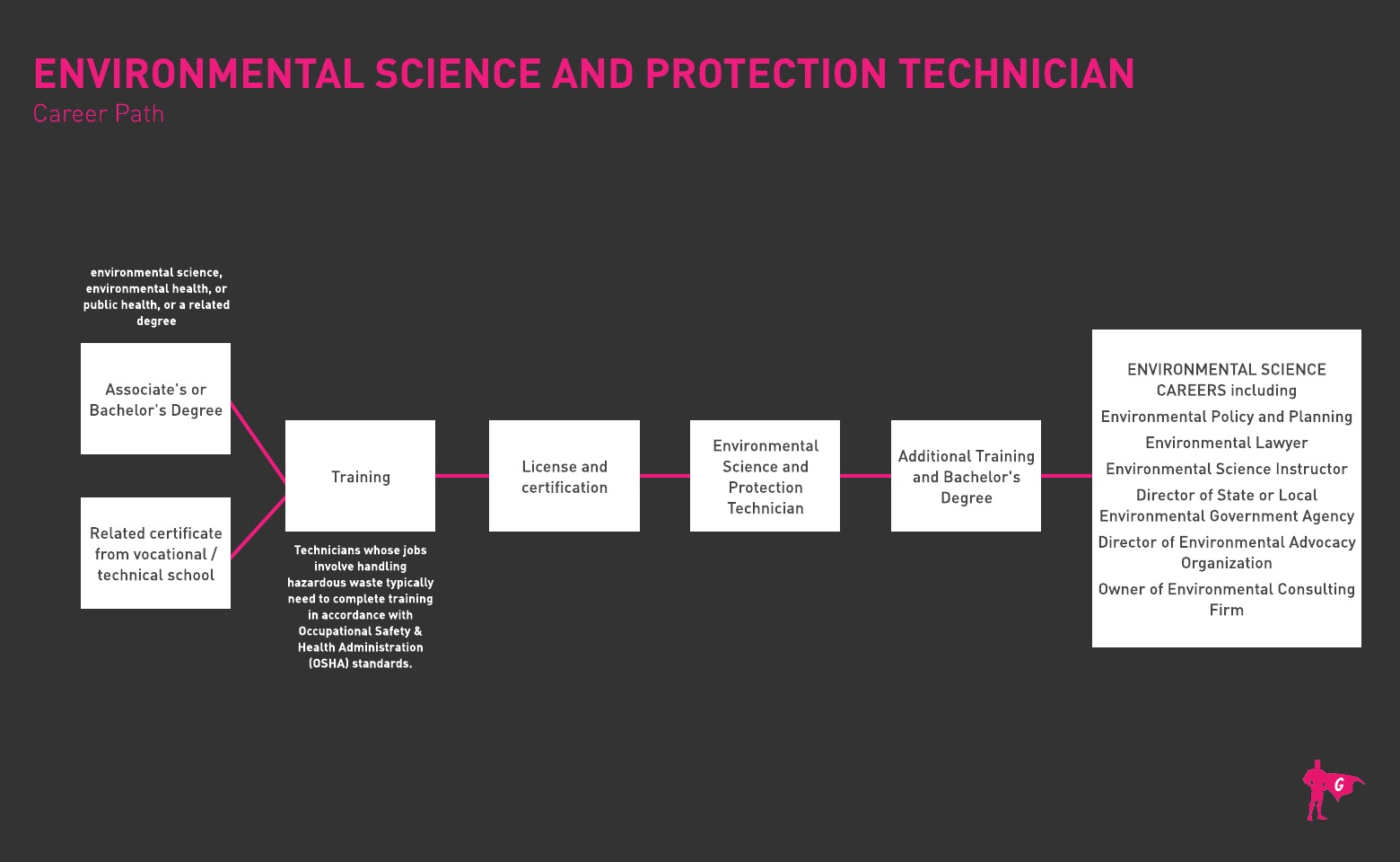Spotlights
Environmental Science Technician, Environmental Protection Technician, Environmental Technician, Health Environmental Science and Protection Technician, Environmental Specialist, Environmental Field Technician, Public Health Sanitarian, Sanitarian, Water Quality Analyst, Water Quality Specialist, Pollution Control Technician, Environmentalist
Environmental Science and Protection Technicians observe our natural environment and explore sources of contamination and pollution. They often collect samples of soil, water, and gases for testing. Typically, these professionals specialize in either field work or lab work, although they can perform duties in both settings.
- Knowing that you are having a positive impact on the environment
- Taking pride in having a “green” job
- Being on top of the latest environmental issues that affect our world
- Playing an important role in keeping people safe
- Performing a variety of different types of tasks in a day
- Working with others who care about the welfare of people and the environment
- Set up equipment to monitor pollution levels and emissions
- Collect soil, water, and air samples for testing
- Inspect businesses and public places for environmental, heath, or safety hazards
- Use data to make reports summarizing test results and discuss them with different parties
- Make sure organizations are in compliance with regulations that prevent pollution
- Design programs that monitor the environmental impact of pollution or radiation
- Investigate outbreaks of food poisoning/disease or hazardous spills/conditions to collect data for analysis
A day in the life of an environmental science and protection technician could involve working in an office, a lab, or in the field. They work with a variety of professionals, including environmental scientists and specialists, engineers, geoscientists, hydrologists, and technicians in other fields.
General skills
- Analytical skills
- Communication skills
- Critical thinking
- Interpersonal skills
- Active listening
- Reading comprehension and speaking skills
- Science background
Technical skills
- Analytical or scientific software
- Computer aided design (CAD) software
- Electronic mail software
- Enterprise resource planning (ERP) software
- Map creation software
- state or local governments
- consulting firms
- testing laboratories
For some professionals in this field, their day to day work can be dramatically affected by the weather. Longer hours may be required when conditions are favorable to being outside to take samples and gather data. Being willing to work in various conditions and being flexible with schedule changes will help someone advance to higher positions.
- Increasing renewable energy sources
- Reducing energy consumption
- Promoting regenerative agriculture
- Greater usage of plastic recycling and biodegradable products
- Addressing human waste management
- Better climate change practices
- Curbing carbon emissions from cement
- Making air travel more energy efficient and eco-friendly
- Liked being outdoors and doing hands-on activities
- Liked science and researching topics they find interesting
- Curious about the environment, plants, and animals
- Feel strongly about the welfare of our planet and want to make a difference in the world
- Entry-level Environmental Science and Protection Technicians should have at least an associate’s degree in environmental science, environmental health, public health, or something similar. Most have a bachelor’s and a master’s should qualify you for a higher starting position
- O*Net notes that 14% of workers in this field have an associate’s, 55% a bachelor’s, and 14% a master’s
- Common courses to take include chemistry, biology, geology, physics, math, statistics, and computer science. Students also need lab experience and to learn about remote sensing technologies and geographic information systems
- Environmental Science and Protection Technicians handling hazardous waste require Occupational Safety & Health Administration training related to identifying and safely working around health hazards, proper use of personal protective equipment, and decontamination protocols, as applicable
- Certification and other training options include:
- Academy of Board Certified Environmental Professionals - Certified Environmental Professional
- Certified Wildlife Rehabilitator
- Ecological Society of America - Certified Ecologist
- Institute for Sustainability - AIChE Credential for Sustainability Professionals
- International Society of Sustainability Professionals - Sustainability Excellence Associate
- National Environmental Health Association - Registered Environmental Health Specialist/Registered Sanitarian
- National Radon Safety Board - Radon Measurement Technician
- National Registry of Environmental Professionals - Associate Environmental Professional
- National Wildlife Federation - EcoLeaders
- OSHA - Certified Environmental Specialist
- Society of American Foresters - Candidate Certified Forester
- Wildlife Society - Associate Wildlife Biologist
- Enroll in classes such as environmental science, health sciences, biology, math, chemistry, engineering, communications, geography, and computer technologies
- Volunteer to participate in river clean-up projects, adopt a highway programs, or other environmental projects to gain real-world experience
- Engage in school activities where you can practice project management, interpersonal skills, leadership, teamwork, and conflict resolution as you collaborate with others, work through problems, and achieve predetermined goals
- Think about where you want to work. Many technicians in this line of work are employed by consulting firms, state or local governmental agencies, or in test laboratories. Some jobs require more fieldwork than others

- There is a wide range of education and training opportunities for Environmental Science and Protection Technicians. Some schools and programs work closely with recruiters who are looking to hire graduates
- Ask your school’s career center for help with resumes and mock interviews, too
- Chat with people you volunteer with in your local area. They may be familiar with job opportunities
- Check out Indeed’s Environmental Science and Protection Technician internship openings
- Attend job fairs in your area and take copies of your resume
- Sign up for alerts on job portals such as Indeed, Simply Hired, Glassdoor, Google for Jobs, and Zippia
- Advertise your availability on LinkedIn and other networking sites
- Request to do informational interviews with working professionals who might have job-seeking tips
- Some states have a greater need for Environmental Science and Protection Technicians than average. The states with the highest concentration of jobs are West Virginia, Alaska, New Mexico, Wyoming, and Florida
- Ask your professors, supervisors, and co-workers in advance if they’ll act as personal references
- Review Environmental Science and Protection Technician resume templates to get ideas
- Study Environmental Science and Protection Technician interview questions to prep for interviews. Be ready to answer in-depth questions about laws such as the EPA’s Toxic Substances Control Act, Clean Water Act, and Clean Air Act
- Always dress for interview success and take notes (after the interview) of what questions were asked
Websites
- Academy of Board Certified Environmental Professionals
- Air and Waste Management Association
- American Chemical Society
- American Mosquito Control Association
- American Public Health Association
- American Society for Microbiology
- ASTM International
- Board of Environmental, Health and Safety Auditor Certifications
- Coordinating Council on the Clinical Laboratory Workforce
- Environmental Protection Agency
- National Association of Environmental Professionals
- National Environmental Health Association
- Occupational Safety and Health Administration
Books
These job titles have similar responsibilities as an environmental science and protection technician:
- Agricultural and food science technicians
- Biological technicians
- Chemical technicians
- Clinical laboratory technologists and technicians
- Environmental engineering technicians
- Environmental scientists and specialists
- Forensic science technicians
- Geological sample test technicians and geoscientists
- Hydrologists
- Environmental compliance inspectors
- Geodetic surveyors
- Soil and water conservationists
Environmental science and protections jobs are rated #3 on U.S. News & World Report’s 2020 “Best Science Jobs” based on expected growth, salary, unemployment rate, stress level, work/life balance and other factors. For those who are interested in the natural world and having a positive impact on the future, the field of environmental science and protection can be a great professional pursuit.
Newsfeed

Featured Jobs

Online Courses and Tools








